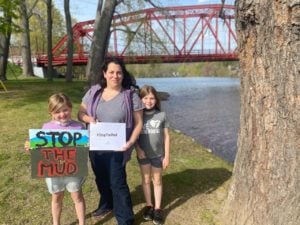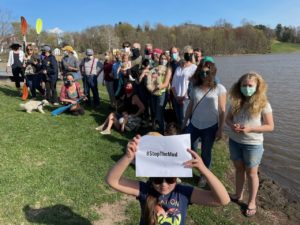Stop the Mud: Community comments

View more images on our Flickr site
Members of the public speak out about NYC’s muddy releases from Ashokan Reservoir into Lower Esopus Creek.
Communities and individuals are speaking out against the massive releases of turbid water from New York City’s Ashokan Reservoir into the Lower Esopus Creek. Below is an assortment of commentary drawn from public statements, testimony and municipal resolutions.
To learn more, visit our information page and community toolkit: Riverkeeper.org/stopthemud
Riverkeeper testimony
NEW: Riverkeeper’s formal comments on the Draft Environmental Impact Statement, June 16, 2021
“DEP failed to take the required hard look at the range of structural alternatives, as identified in the 2013 consent order, to minimize or avoid turbid discharges to the Lower Esopus. This is not a hard look. In fact, it’s hardly any look at all.”
– Paul Gallay, President and Hudson Riverkeeper
Read our full testimony for the March 3, 2021, Public Hearing
“The DEP is kicking the can down the road, ignoring the climate crisis while trying to safeguard its drinking water supply on the backs of the downstream communities.”
– Paul Gallay, Riverkeeper statement, May 4, 2021
Municipal resolutions and letters
“The Hudson River is a critical regional drinking water supply, including for the Dutchess County City and Town of Poughkeepsie. Protecting water quality in this drinking water source is an important regional priority.”
– Town of Poughkeespie resolution, March 3, 2021
“The Lower Esopus is an important contributor to the social, economic and environmental quality along the creek’s corridor. It cannot be the solution to NYC’s turbid water problems.”
– Town of Esopus resolution, April 1, 2021
“The Town of Rhinebeck relies on the Hudson River to supply safe and potable drinking water to its thousands of residents … (and has) serious concern about New York City’s discharge of turbid water from the Ashokan Reservoir into the lower Esopus Creek, which in turn flows into the Hudson River.”
– Town of Rhinebeck resolution, April 12, 2021
“The Hudson River is a critical regional drinking water supply, including for over 100,000 people in the Mid-Hudson Region. Protecting water quality in this drinking water source is an important regional priority.”
– Village of Rhinebeck resolution, April 13, 2021
“The City of Poughkeepsie relies on the Hudson River to supply safe and potable drinking water to its thousands of residents…(and has) serious concern about New York City!s discharge of turbid water from the Ashokan Reservoir into the lower Esopus Creek, which in turn flows into the Hudson River.”
– City of Poughkeepsie resolution, April 19, 2021
“The Town of Hyde Park relies on the Hudson River to supply safe and potable drinking water to its thousands of residents…(and has) serious concern about New York City’s discharge of turbid water from the Ashokan Reservoir into the lower Esopus Creek, which in turn flows into the Hudson River.”
– Town of Hyde Park resolution, April 20, 2021
“Solving New York City’s turbidity problem by giving the Hudson 7 a turbidity problem is not a fair solution, and yet that is essentially what would result from accepting the DEIS.”
– Letter to DEC Commissioner Basil Seggos from the Hudson River Intermunicipal Council (aka “Hudson 7” – Town of Esopus, Town of Hyde Park, Town of Lloyd, City of Poughkeepsie, Town of Poughkeepsie, Town of Rhinebeck, Village of Rhinebeck)
“We as members of Rondout Rowing Club (RRC) of Kingston, New York are urging the
NYSDEC to exercise its authority to enforce the state and federal laws that protect water quality in evaluating the impacts of NYCDEP releases to the Lower Esopus Creek….Part of the mission of RRC is to foster awareness of the unique natural resources of the Hudson River. Specifically our charge is to advocate for the protection of the environmental and recreational integrity of the Rondout Creek and Hudson River so that succeeding generations of rowers can experience the exhilaration and joy of rowing…Kingston, 10 miles south of Esopus entry to Hudson, is seeing an impact on fish and birdlife. Indeed the Saugerties Seal left its home by the Lighthouse in Saugerties because of a decreased number of fish.”
– Letter to DEC Commissioner Basil Seggos from the Rondout Rowing Club
“The potential and actual short-term, long-term and cumulative impacts on the downstream communities along the Esopus Creek and Hudson River must be recognized and thoroughly studied within the DEIS, including impacts on other drinking water systems, the local economy, recreation and the aesthetics of the area.”
– City of Kingston resolution, May 1, 2021
“The Town of Lloyd has serious concern about New York City’s discharge of turbid water from the Ashokan Reservoir into the Lower Esopus Creek, which in turn flows into the Hudson River.”
– Town of Lloyd resolution, May 5, 2021
“The Hudson River Drinking Water Intermunicipal Council (Hudson 7) is made up of elected leaders from seven municipalities that rely on drinking water drawn from the Hudson River: the City of Poughkeepsie, the Village of Rhinebeck and the Towns of Esopus, Hyde Park, Lloyd, Poughkeepsie and Rhinebeck…the Hudson 7 has estimated the volume of solids discharged by New York City following the Christmas 2020 storm at 8,240,000 pounds (4,120 tons), equivalent to 294 loads by 14-ton dump trucks.”
– Hudson 7 resolution, May 20, 2021
“Saugerties contends that the delivery of clean water to the customers of New York City
and 12 upstate communities cannot be accomplished without addressing the collateral
environmental damages that occur as a consequence of that delivery process, including
the impacts of turbid water discharges into the Lower Esopus Creek. Otherwise, the DEIS
is deficient and should be rejected.”
– Town of Saugerties
“The lack of progress is all the more remarkable since the Upper Esopus, the Ashokan Reservoir, and the Lower Esopus are all 303(d) water quality listed as impaired for sediment and turbidity, and it is DEC’s responsibility to develop a way to clean them up. In listing the Lower Esopus as impaired (over DEC’s objection), US EPA found that “[d]uring the 2012 303(d) listing cycle, New York did not demonstrate that the management actions currently in place constitute pollution control requirements that will result in attainment of water quality standards for turbidity in the Lower Esopus Creek within a reasonable period of time.”30 Eight years later DEC still cannot demonstrate any such pollution control that will result in attainment of water quality standards any time soon.”
– Catskill Mountainkeeper, June 16, 2021
Community comments
“We are acutely aware in Ulster County that for generations, the City of New York has benefited from and depended upon our clean water. Today we are simply asking for accountability. The NYC DEP relies on our resources in Ulster County to supply water for 9 million of their residents. If you are going to use our resources, you should also be held accountable for the impact that you have to our environment and to our communities.”
– Ulster County Executive Pat Ryan
[Read Ulster County DEIS comments]
“I request that DEC find the DEIS incomplete and require the consideration of drinking water, ecological, and recreational impacts as well as conducting an analysis that pairs alternatives to achieve multiple goals of flood control and water quality downstream, as well as through the Catskill Aqueduct.”
– March Gallagher, Ulster County Comptroller
“Dutchess goes on record supporting the concerns expressed by our neighbor and friend, Ulster County about the damage being done in the Lower Esopus Creek.”
– Dutchess County Executive Marcus J. Molinaro
“The staggeringly high levels of turbidity in the Lower Esopus Creek pose a direct threat to our quality of life, our tourism economy, our local businesses and recreational activities, and our precious wildlife. The way the system is working is not working, and with severe storms growing in number year over year, sustained turbidity will only get worse for the Esopus Creek and surrounding communities. We need transparency into the actions taken and a good faith effort to bring mitigating solutions to the table. I stand with our watershed communities and local business owners in the call for the Lower Esopus Creek to be restored and protected, as it should be, and urge all Ulster County residents to make their voices heard with public comment by the June 16th deadline.”
– New York State Senator Michelle Hinchey
“The impacts of the release of turbid water to the Lower Esopus Creek, as governed by this draft permit, have not been completely studied, alternatives have not been sufficiently analyzed, and management solutions proposed are inadequate to protect the estuary, its tributaries, and the human and non-human life that depends on them.”
– Stuart Findlay, Chair, Hudson River Estuary Management Advisory Committee
“The DEIS does not include the full historical precipitation data record, does not adequately document / incorporate climate change into its analysis, and does not adequately consider alternatives to the proposed action, such as a combined bypass tunnel to the lower Esopus Creek or the east basin of the Ashokan Reservoir. Accordingly, the WIG requests that these deficiencies be corrected in a supplemental DEIS.”
– New York City Watershed Inspector General
 “We would like to reiterate that our primary concern is the health of the Lower Esopus Creek, Hudson River, and all associated communities and resources. We strongly recommend, based on the multiple reasons presented in our Draft EIS comments, that NYSDEC move forward with the preparation of a Supplemental Draft EIS to more accurately assess potential impacts to the natural and human environments, particularly in response to the December 2020 storm/turbidity event.”
“We would like to reiterate that our primary concern is the health of the Lower Esopus Creek, Hudson River, and all associated communities and resources. We strongly recommend, based on the multiple reasons presented in our Draft EIS comments, that NYSDEC move forward with the preparation of a Supplemental Draft EIS to more accurately assess potential impacts to the natural and human environments, particularly in response to the December 2020 storm/turbidity event.”
– Amanda LaValle, Ashokan Release Working Group Technical Subcommittee
“Over the years, I’ve put thousands of people out on the Esopus to enjoy its beauty and experience the abundant wildlife. The [impact] of these releases is very real, so I’m more than a little angry and heartbroken about what’s being done to the creek and the wildlife that calls it home.”
– Gail Porter, Owner, I Paddle New York
“In the Mid-Hudson area there are seven communities that take their drinking water from the Hudson River. Clearly all of them have been negatively impacted by the actions of the NYCDEP. They will not even meet with us and talk about the problem! This area of the Hudson is our drinking water source exactly like their Ashokan reservoir is their drinking water source. Can you imagine their reaction if we took the sludge/mud that our plant takes out of the river water from their turbidity, drove it up to the Ashokan and dumped it into one of the feeder streams? That’s right, immediate, and most likely very strong.”
– Bill Carlos, Councilman, Town of Poughkeepsie, and Vice-Chairman of the
Poughkeepsie Joint Water Board
“New York City’s muddy releases not only impact the Lower Esopus Creek but also the Hudson River estuary where our drinking water supplies come from. This fact has been largely, if not completely, ignored. We demand that the Department of Environmental Conservation hold New York City accountable.”
– Shannon Harris, Supervisor, Town of Esopus, N.Y.
“As a professional engineer in the State of New York, I have serious concerns about the Draft Environmental Impact Statement… These concerns became more apparent after the releases of millions of gallons of water and thousands of tons of solids from the Ashokan Reservoir between 12/28/2020 and 2/12/2020 and 3/10/2021 and 4/17/2021. DEIS has many unanswered questions, the evaluation of alternatives is inadequate, the implementation of a reasonable solution has been delayed because of DEP’s mismanagement of one of the greatest water systems in the world, and interim solutions were not presented in DEIS to stop the muddy discharges immediately.”
– Paul Malmrose, Engineer, Technical Advisor to the Hudson River Intermunicipal Council (“Hudson 7”)
 “As a resident of the lower Esopus Creek waterfront, I am concerned about impacts of Ashokan Reservoir operations. As Executive Director of the Saugerties Lighthouse Conservancy, I write on behalf of a local not-for-profit organization dedicated to the preservation of this historic landmark and whose members cherish this scenic location. They include birdwatchers, boaters, anglers, hikers, photographers, waterfront neighbors, and others who value the habitat and scenery of the area.
“As a resident of the lower Esopus Creek waterfront, I am concerned about impacts of Ashokan Reservoir operations. As Executive Director of the Saugerties Lighthouse Conservancy, I write on behalf of a local not-for-profit organization dedicated to the preservation of this historic landmark and whose members cherish this scenic location. They include birdwatchers, boaters, anglers, hikers, photographers, waterfront neighbors, and others who value the habitat and scenery of the area.
“The lighthouse and adjoining nature preserve receive over 50,000 visitors annually. Earlier this year, our members and visitors watched with dismay as the creek flowed brown throughout the winter and early spring. Anglers were discouraged by the sight of the muddy water and reported that fishing was disappointing in early spring. Birders worried about the effects on waterfowl, ospreys, and bald eagles. Tourists were alarmed by the sight of the murky brown water and worried about what was happening to make the water so cloudy and dirty. As a first-impression for out-of-town visitors, it was obvious that the turbidity in the creek was not what would be considered “normal” or “natural.”
– Patrick Landewe, Executive Director, Saugerties Lighthouse
Community Character Analysis, Aesthetic and Visual impact Assessment
– Harvey K. Flad, Ph.D.
“Over the years, I’ve put thousands of people out on the Esopus to enjoy its beauty and experience the abundant wildlife. The [impact] of these releases is very real, so I’m more than a little angry and heartbroken about what’s being done to the creek and the wildlife that calls it home.”
– Gail Porter, Owner, I Paddle New York
Riverkeeper webinar
En Español
Hoja informativa: Ashokan Embalse: Pare el lodo
La Voz con Mariel Fiori, 27 de abril de 2021 – Sebastian Pillitteri, Riverkeeper


